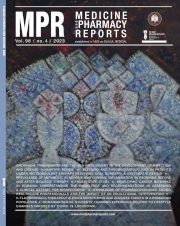Prevalence of metabolic syndrome and chronic inflammation in psoriasis before and after biologic therapy: a prospective study
DOI:
https://doi.org/10.15386/mpr-2631Keywords:
psoriasis, metabolic syndrome, obesity, diabetes, abdominal circumference, chronic inflammationAbstract
Background. As a chronic inflammatory disease, psoriasis affects not only the skin but also the metabolic profile of the patients. Biologic therapies, including tumor necrosis alpha (TNF-a) inhibitors and interleukin (IL)-12/23 and IL-17 antagonists, have proven effective in the reduction of psoriasis severity; however their impact on the metabolic and chronic inflammatory profiles of the patients remains incompletely elucidated.
Methods. We performed a longitudinal case-control study on 106 psoriasis patients and an equal number of controls without the disease, as well as a prospective study on the patient group with the end point being 6 months of biologic therapy. Patients received either ixekizumab, secukinumab, guselkumab, certolizumab, ustekinumab, risankizumab, or adalimumab. Abdominal circumference, serum fasting glucose, triglycerides (TG), high-density lipoproteins (HDL), erythrocyte sedimentation rate (ESR) and C reactive protein (CRP) were measured for both patients and controls, with an additional measurement for patients after 6 months.
Results. At baseline, the number of psoriasis patients suffering from obesity, metabolic syndrome, and chronic inflammation significantly outnumbered controls (p<0.05), with the calculated odds ratio being 1.88, 6.83, and 81.84 for these conditions in psoriasis, respectively. Biologic therapies increased the abdominal circumference of patients in a slight but significant fashion (p<0.05), as well as significantly improved HDL, CRP, ESR levels at 6 months (p<0.05). Moreover, after 6 months, the number of patients meeting the diagnostic criteria for metabolic syndrome and chronic inflammation was significantly lower than at baseline (p<0.001).
Conclusions. According to our results, biologic therapies improve the overall metabolic and inflammatory profiles of psoriasis patients, the most significant ameliorations being noticed for serum HDL, CRP, and ESR.
Downloads
Published
How to Cite
Issue
Section
License
The authors are required to transfer the copyright of the published paper to the journal. This is done by agreeing to sign the Copyright Assignment Form. Whenever the case, authors are also required to send permissions to reproduce material (such as illustrations) from the copyright holder.

The papers published in the journal are licensed under a Creative Commons Attribution-NonCommercial-NoDerivatives 4.0 International License.

